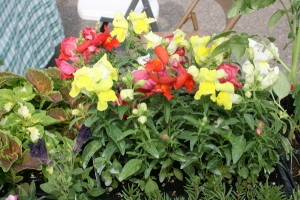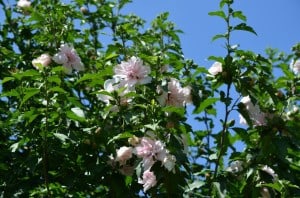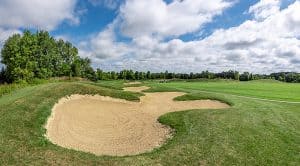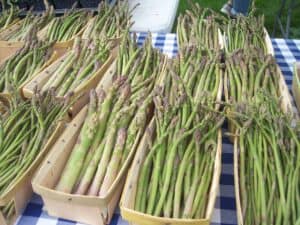 (Chelsea Update would like to thank Jennifer Fairfield, owner of the Garden Mill, for the information in this story. Part two will publish tomorrow.)
(Chelsea Update would like to thank Jennifer Fairfield, owner of the Garden Mill, for the information in this story. Part two will publish tomorrow.)
Well, the weather lately has been living up to its reputation in Michigan – unpredictable. We had fabulous, warm, sunny weather for a little bit, sandwiched in between some chilly (ok – cold) wet stuff.
It may not seem like it now, but the weather gurus are saying that this May will be warmer and dryer than normal. Don’t get too comfortable with that though – they are also saying that it will be cooler and wetter in June, while July and August are predicted to be pretty close to normal.
What does all this mean to us?
Well, if things warm up quickly, we may be able to get some of our warm-weather loving plants into our gardens a little earlier than normal. However, if June is cooler and wetter, you can be sure that we will be battling diseases like powdery mildew, early blight, and fusarium wilt. Keep your fungicides handy.
May is prime gardening time. There’s so much to do this month, and the weather can make getting everything done a challenge. Even if you don’t consider yourself a gardener, there’s still a lot to do, regardless of the size of your yard.

Vegetables and Herbs:
Don’t be in too much of a hurry to get some things planted in your veggie garden. Wait until the weather has warmed up a little bit before planting tomatoes, peppers, eggplant, cucumbers, squashes, and most herbs.
It’s generally best to wait until there is no danger of frost, which is typically around May 15. We may have seen our last frost for the year already, but it’s impossible to know for sure.
There are two things to look for before planting these warm-weather loving plants: nighttime temperatures consistently over 50°, and soil temps over 60°. Putting your veggie seedlings into cold soil will shock them and can stunt their growth, delaying their fruit production. So, rather than risk that, wait until conditions are right. A soil thermometer takes the guesswork out of that timing.
It’s not too early (or quite too late yet, either) to plant onions, potatoes, strawberries, asparagus, broccoli, cabbage, and kale. Don’t wait too much longer, though.
Once it gets really warm, you run the risk of cool-weather plants like broccoli and cabbage bolting (going to seed, and being inedible). Onions and potatoes need a pretty long growing season, so waiting too long to get those planted could mean that you end up with little or nothing to show for your efforts at the end of the season.
Strawberries and asparagus will need all the growing time they can get this year, and into next year before you see anything edible, so getting them going early will help them get established.
Potatoes
One really good reason to grow your own potatoes is that commercially grown potatoes tend to be grown using lots of pesticides. The reason for this is that potato beetles are some of the most destructive pests in the world of crops, and they are also very difficult to kill. So, potato growers tend to go after them with large amounts of chemicals. If you’re not interested in consuming lots of pesticide residue with your meals, growing your own, organically, is a relatively easy alternative.
Seeds to plant now include spinach, lettuce, carrots, radishes, and beets. About mid-month, it’s safe to plant beans of all sorts. Squash, cucumber, dill, and cilantro seeds can be planted directly into your garden mid-month as well.
 Flowers:
Flowers:
Plant most annuals in the ground about the same time you plant warm-weather vegetables – once nighttime temps are consistently above 50° and soil temperatures reach 60°. There are some annuals, such as nemesia, snapdragons, and osteospermum, which can stand a few frosts, as long as they have been hardened off.
Hardening off is the process of getting plants used to the outdoor environment. If plants have been living in heated greenhouses, then you don’t want to take them from that environment and plant them in cold soil, and leave them to the mercy of the chilly nighttime temperatures that we will be getting over the next week or two.
If you buy something that’s been living indoors, gradually get it used to the outdoors, starting with a few hours in the mid-day warmth, and gradually increasing the amount of time you leave it out, over the course of about two weeks. If frost threatens after you have planted things outdoors, use row covers to keep them a little warmer.

Most perennials can be planted out any time now – as long as they were grown outdoors or have been hardened off.
If you have summer-blooming perennials in need of dividing and transplanting, do this task early in the month, so that the plants have time to put down roots in their new homes before they are expected to bloom. Wait to divide and move early blooming perennials until after they have finished blooming.
Mulch flower beds after the soil has warmed up. Mulching while the soil is cold will keep the soil cool longer, and slow growth of your flowers. If existing mulch has compacted over the winter, fluff it up with a garden fork.
Compacted mulch keeps water from reaching the plant’s roots. Before adding mulch, work a layer of compost into the soil, or add an organic fertilizer to give your plants a nutrient boost.
(Part two will publish tomorrow.)


















